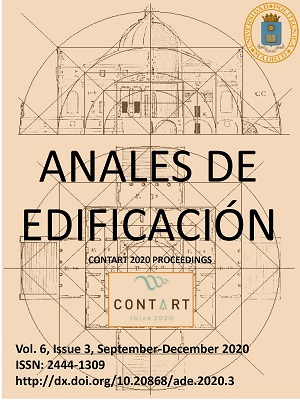Proyecto LIFE PHOTOSCALING : la sostenibilidad de la tecnología fotocatalítica en pavimentos urbanos = LIFE PHOTOSCALING project: the sustainability of photocatalytic technology in urban pavements for air decontamination
DOI:
https://doi.org/10.20868/ade.2020.4619Palabras clave:
Fotocatálisis, Construcción, Calidad del Aire, Photocatalisys, Construction, Air quality.Resumen
El objetivo global del proyecto PHOTOSCALING del programa LIFE de la UE, es demostrar la validez, de manera sostenible, de la tecnología de fotocatálisis en núcleos urbanos. El proyecto PHOTOSCALING-LIFE pretende aportar claridad y responder a la pregunta de si la aplicación de materiales de construcción fotocatalíticos en una gran ciudad, como Madrid, es positiva y efectiva, cuantificando los beneficios y los posibles efectos secundarios perjudiciales durante toda su vida. En otras palabras, tiene la intención de demostrar la sostenibilidad del uso de este tipo de tecnología.
Abstract
The overall objective of the PHOTOSCALING project of the EU LIFE program is to demonstrate the validity, in a sustainable way, of photocatalysis technology in urban environments. The PHOTOSCALING-LIFE project aims to provide clarity and answer the question of whether the application of photocatalytic building materials in a large city, such as Madrid, is positive and effective, quantifying the benefits and possible harmful side effects throughout its life. In other words, it is intended to demonstrate the sustainability of the use of this type of technology.
Descargas
Referencias
Bengtsson, N.; Castellote, M. (2014). Heterogeneous photocatalysis on construction materials: effect of catalyst properties on the efficiency for degrading NOx and self cleaning, Materiales de Construcción, 64, 013.
Bloh, J.Z.; Folli, A.; Macphee, D. (2014) Photocatalytic NO x abatement: Why the selectivity matters, 4, 45726-45734.
Cordero, J.; Hingorani, R.; Jimenez, E.; Grande, M.; Borge, R.; Narros, A.; Castellote, M. (2020). NOx removal efficiency of urban photocatalytic pavements at pilot scale, Science of The Total Environment, (2020) 137459.
Cordero, J.; Hingorani, R.; Jimenez, E.; Grande, M.; Cutillas, F.; Martinez, E.; Borge, R.; Narros, A.; Castellote, M. (2021). Challenges in quantification of photocatalytic NO2 abatement effectiveness under real world exposure conditions illustrated by a case study, Science of The Total Environment, 766, 144393.
Folli, A.; Jakobsen, U.; Guerrini, Macphee, D. (2009). Rhodamine B discolouration on TiO2 in the cement environment: a look at fundamental aspects of the self-cleaning effect in concretes, 12, 126-133.
Fujishima, A.; Honda, K.J.n. (1972). Electrochemical photolysis of water at a semiconductor electrode, 238 (1972) 37.
Fujishima, A.; Hashimoto, K.; Watanabe, T. (1999) TiO2 Photocatalysis: Fundamentals and Application, 1edm ed., Tokyo, 1999.
Jimenez, E.; Castellote, M. (2014). Influence of the inlet air in efficiency of photocatalytic devices for mineralization of VOCs in air-conditioning installations, Environ. Sci. Pollut. Res., 21, 11198-11207.
Jimenez, E.; Rodriguez, J.; Castillo, A.; Castellote, M. (2015). Characteristics and efficiency of photocatalytic cementitious materials: Type of binder, roughness and microstructure, Cem Concr Res, 71, 124-131.
Hu, C.; Guo, J.; Qu, J.; Hu, X. (2007). Photocatalytic degradation of pathogenic bacteria with AgI/TiO2 under visible light irradiation, Langmuir, 23, 4982-4987.
Habibi, A.; Asadzadeh, S.; Feizpoor, S.; Rouhi, A. (2020). Review on heterogeneous photocatalytic disinfection of waterborne, airborne, and foodborne viruses: Can we win against pathogenic viruses?, Journal of Colloid and Interface Science.
Hingorani, R.; Jimenez, E.; Grande, M.; Castillo, A.; R. Nevshupa, Castellote, M. (2020). From analysis to decision: revision of a multifactorial model for the in-situ assessment of NOx abatement effectiveness of photocatalytic pavements, Chemical Engineering Journal, 126250.
Jimenez, E.; Castellote, M. (2015). Quantification of hydroxyl radicals on cementitious materials by fluorescence spectrophotometry as a method to assess the photocatalytic activity, Cem Concr Res, 74, 108-115.
Jimenez, E.; Castellote, M. (2018). Hydroxyl radical and free and shallowly trapped electron generation and electron/hole recombination rates in TiO2 photocatalysis
using different combinations of anatase and rutile, Applied Catalysis A: General.
Jimenez, E.; Hingorani, R.; Rubiano, F.; Grande, M.; Castillo, A.; Castellote, M. (2019). In situ evaluation of the NOx removal efficiency of photocatalytic pavements: statistical analysis of the relevance of exposure time and environmental variables, Environ. Sci. Pollut. Res., 26, 36088-36095.
Jimenez, E.; Castellote, M. (2019). Quick assessment of the photocatalytic activity of TiO2 construction materials by nitroblue tetrazolium (NBT) ink, Construction and Building Materials, 214, 1-8.
Jimenez, E.; Grande, M.; Duran, T.; Castillo, A.; Castellote, M. (2020a). Environmental impact of nano-functionalized construction materials: leaching of titanium and nitrates from photocatalytic pavements under outdoor conditions, Science of The Total Environment, 140817.
Jimenez, E.; Rubiano, F.; Hingorani, R.; Grande, M.; Castillo, A.; Nevshupa, R.; Castellote, M. (2020b). A New Holistic Conceptual Framework for Assessment of Photocatalytic Pavements Performance, Frontiers in Chemistry, 8, 743.
Mills, A.; Hill, C.; Robertson, P.K. (2012). Overview of the current ISO tests for photocatalytic materials, J. Photochem. Photobiol. A Chem., 237, 7-23.
Nevshupa R.; Grande M.; Martínez E.; Castellote M. (2020). Assessment of urban air pollution related to potential nanoparticle emission from photocatalytic pavements, J. Environ. Manage., (2020).
Sapiña, M.; Jimenez, E.; Nevshupa, R.; Roman, E.; Castellote, M. (2017). Degradation of pollen on nanofunctionalized photocatalytic materials, Journal of Chemical Technology & Biotechnology, 92, 210-216.
Schaberg, P.; Botha, J.; Schnell, M.; Hermann, H. O.; Pelz, N.; Maly, R. (2005). Emissions performance of GTL diesel fuel and blends with optimized engine calibrations, SAE transactions, 1074-1087.
Descargas
Publicado
Número
Sección
Licencia
1. Los autores conservan los derechos de autor y garantizan a la revista el derecho de una Licencia Creative Commons Atribución - Nocomercial 4.0 Internacional que permite a otros compartir el trabajo con un reconocimiento de la autoría y uso no comercial.
2. Los autores pueden establecer por separado acuerdos adicionales para la distribución no exclusiva de la versión de la obra publicada en la revista (por ejemplo, situarlo en un repositorio institucional o publicarlo en un libro).
Salvo indicación contraria, todos los contenidos de la edición electrónica se distribuyen bajo una licencia de uso y distribución “Creative Commons"












